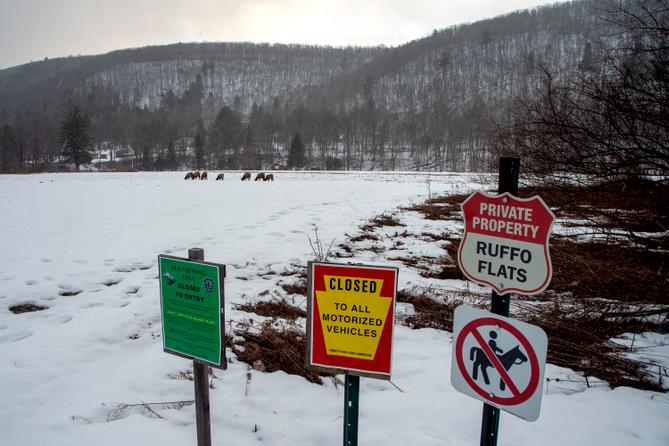Spotlight PA is an independent, nonpartisan newsroom powered by The Philadelphia Inquirer in partnership with PennLive/The Patriot-News, TribLIVE/Pittsburgh Tribune-Review, and WITF Public Media. Sign up for our free newsletters.
HARRISBURG — A proposal that would allow military planes to fly training missions less than a quarter-mile above a section of Pennsylvania prized for its preserved wilderness has left residents with more questions and concerns than answers.
The Maryland Air National Guard wants to lower the threshold for combat training flights to just 100 feet above ground level, sparking concerns that noise could cause tourism to decline, impact wild elk and bald eagles, and lower the quality of life for residents.
While an environmental assessment found there won’t be a significant impact on the region, some residents and wildlife organizations want a more comprehensive analysis and public meetings to address their concerns.
Here’s what you need to know.
What does the guard want to do?
The proposal would lower the altitude limit for fighter jet training missions from 8,000 feet above sea level to 100 feet above ground — approximately the height of a 10-story building — over parts of Elk, Cameron, Clinton, McKean, Potter, and Tioga Counties.
The affected area is part of what’s known as the Pennsylvania Wilds, a rural region of the state that is home to state parks, wildlife including elk, and hundreds of miles of trails.
Its scenic rivers and wildlife, elk herds, and dark skies make it a magnet for outdoor recreation. In 2019, tourists spent an estimated $1.8 billion in the region, and the tourism industry accounted for over a tenth of the region’s employment.
According to Jamie Flanders, airspace manager for the Air National Guard, planes already fly as low as 100 feet in the area. The change, he said, would allow for multi-direction training flights, as opposed to flights in one direction.
“Military routes already go down to 100 feet, so there should be no change,” Flanders said. “If you’re not affected now, you won’t be affected later.”
Starting in 2019, the National Guard Bureau sent letters to state, federal, and local officials and government entities, including Native American tribes, providing them with detailed information about the proposal and plans to conduct an environmental assessment, Flanders said.
In response to feedback, Flanders said, the bureau decided state parks, historic areas, and bald eagle nests would be excluded from low-altitude flights.

Who is concerned and why?
Residents, business owners, and some county officials are concerned noise from the aircraft could negatively impact the community, wildlife, and the tourism industry.
A draft environmental assessment released by the Maryland Air National Guard in October found that noise would not be significant enough to cause damage, but there would be “minor” impacts, such as noise loud enough to startle people or rattle windows. The noise would startle animals, the report said, but it would not be significant because of the short time period planes would be at low altitudes.
The assessment used noise modeling conducted under Federal Aviation Administration and EPA standards, which estimate average noise impacts. Flanders said some residents requested a test run, but the modeling is preferable because noise can vary from day to day based on environmental conditions such as wind speed and temperature.
So far, those who live in the area are skeptical.
“I have a hard time believing this will not impact quality of life for residents, wildlife, livestock, the visitor experience, and small businesses dependent on visitor spending,” Ta Enos, CEO of the nonprofit PA Wilds Center for Entrepreneurship, said in a November press release.
At a Nov. 18 meeting of the Clinton County Commissioners, Vice Chairman Jeffrey Snyder said he shares his constituents’ concerns.
“You won’t find three commissioners who are more supportive of the military. That’s not what this is about. This is about rural constituents’ ways of life,” he said. “Now, we’re not saying that we’re not willing to do some discussion, but we haven’t had the opportunity to have that discussion.”
Snyder told Spotlight PA he’s heard from a veteran with PTSD who is worried that the low altitude flights would be a trigger, and he’s heard from operators of a natural gas storage facility who are uncomfortable with low altitude flying over them.
The guard is unable to conduct studies on veterans with PTSD, Flanders said, because those medical records are private. But if individual veterans call the Maryland Air National Guard concerned that the noise could trigger their PTSD, it can carve out noise avoidance areas, something that Flanders said has been done in the past.
Elected officials and residents are also concerned about negative impacts on Life Flight, an air ambulance service that responds to medical emergencies in northern Pennsylvania.
But Flanders said those flights have priority and air traffic control knows to tell military flights to move out of the way.
“We would never ever do anything to impede the activities of a medical emergency,” Flanders said.
What does the community want, and what happens next?
At the moment, community demands boil down to three things: more public input, further analysis, and more time to comment on the draft environmental assessment.
One of those has been granted.
In response to extension requests by the state Conservation & Natural Resources Advisory Council, the PA Wilds Center, and several counties, the Maryland Air National Guard extended the Dec. 15 public comment deadline to Dec. 31.
Some community leaders also want the Maryland Air National Guard to hold public meetings and to conduct an environmental impact statement, which is a much more comprehensive and rigorous assessment under the National Environmental Policy Act.
Flanders said the Maryland Air National Guard does not plan to hold public meetings or conduct an environmental impact statement at the moment, though that could change in January.
The guard plans to spend the first two to three weeks of the year analyzing public comments and comparing them to the environmental assessment’s conclusions. If the comments show it’s necessary, Flanders said an environmental impact statement — which requires public meetings — will be conducted.
Ultimately, the FAA has the final say over the proposal. After the public comment period ends and analysis is complete, Flanders said the Air National Guard will publish the final environmental assessment and submit the request to the FAA. He anticipates the plan could be implemented as soon as late 2022.
WHILE YOU’RE HERE… If you learned something from this story, pay it forward and become a member of Spotlight PA so someone else can in the future at spotlightpa.org/donate. Spotlight PA is funded by foundations and readers like you who are committed to accountability journalism that gets results.

